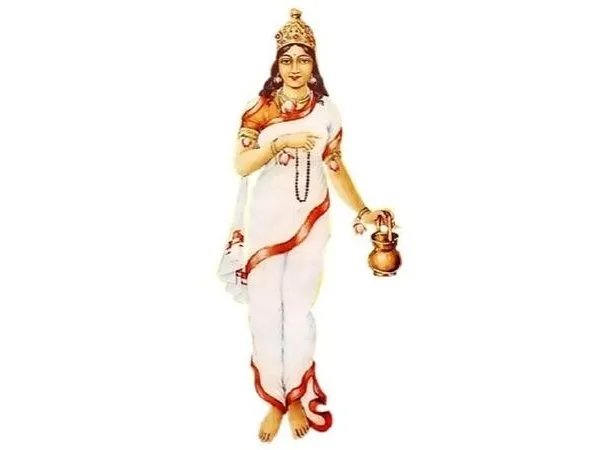
Brahmacharini represents Parvati in her phase of asceticism.
When Shailaputri or Parvati wanted to marry Shiva, she started doing formal puja to the Lord but the celestial sage Narada came to her and told her that Shiva being a true ascetic, would not be attracted by her beauty but only by her ascetism. So, she started doing severe austerities for many years. Hence, she was given the name of Brahmacharini – a celibate seeker.
The word brahmacharini stems from two Sanskrit roots:
Brahma(ब्रह्म), means "the one self-existent Spirit, the Absolute Reality, Universal Self, the sacred knowledge" and charini is the feminine version of one who is a charya(चर्य), which means "occupation with, engaging, proceeding, behaviour, conduct, to follow, moving in, going after". The word brahmacharini in Vedic texts means a female who pursues sacred religious knowledge.
According to different versions of her story, maiden Parvati resolves to marry Shiva. Her parents try to discourage her, but she remains steadfast and performs a penance for about 5000 years.
In the meantime, the gods approach Kamadeva, the Hindu god of love and lust, and ask him to generate desire in Shiva for Parvati. They are driven by an asura named Tarkasur who can only be killed by Shiva's child. Kamadeva shoots Shiva with an arrow of desire. Shiva opens his third eye in his forehead and burns Kama to ashes.
Parvati does not lose her hope or her resolve to win over Shiva. She begins to live in mountains like Shiva and engage in the same activities he does, such as asceticism, yogin and tapas. Her ascetic pursuit draws the attention of Shiva and awakens his interest. Shiva at last visits Paravati in disguise of Bhramachari and tries to dissuade her by counting Shiva's weaknesses and personality problems. Parvati refuses to listen and insists in her resolve. He then examines Parvati by giving her riddles, which she all answers correctly. After praising Parvati for her wisdom and beauty, Brahmachari proposes to her. Parvati realizes he is Shiva and accepts. Shiva appears in his true form and finally accepts her. During the entire tapas Pravati was feeding herself with belpatra and river water.
During this time, the demon named Prakandasura attacks Parvati with his million asuras. Parvati is at the last stage of completion for her tapas, and is unable to defend herself. Seeing Parvati helpless, goddesses Lakshmi and Saraswati intervene but are outnumbered by the demons. After many days of fighting, the kamandalu beside Parvati falls and all the demons are washed away in the resulting flood. At last, Parvati opens her eyes, emitting fire and burning the demon to ashes.
Everyone in the universe is impressed by the tapas performed by Devi Parvati, except
On the second day the seekers who are following the rituals of the nine nights should stop all the fripperies of life in the world and take to deep penance and spend this night in meditation alone. They should repeat her mantra and focus on her dhyana shloka. This applies to all the nine goddesses.
We have been given a good description of her form and the mantra and shloka for mediation. She is fair and has three eyes. Her face is calm and she is dressed in white as befitting an anchorite and adorned with a necklace of rudraksha seeds. She walks barefoot carrying the japa mala (rosary) in her right hand and kamandalu (water pot carried by all ascetics) in her left.
Her planet is Mars or Mangal which is a malefic planet so devotion to her will reduce the ill effects of this planet. Her favourite colour is white and favourite flower, Chrysanthemum.
Mother Brahmacharini represents the Svādhiṣṭhāna chakra in spiritual practice. Sadhaks and yogis keep their mind on Svādhiṣṭhāna to maintain their devotion and dedication in a steady phase.
“Oṁ Devi Brahmācāriṇyai Namaḥ!”
ॐ देवी ब्रह्मचारिण्यै नमः॥